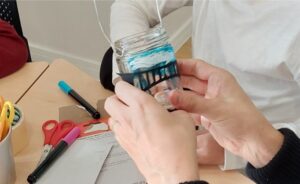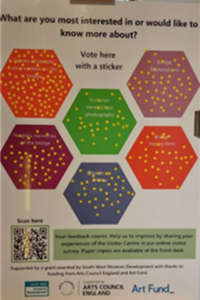 Overview
Overview
Clifton Suspension Bridge is one of Bristol’s best-known landmarks. The Clifton Suspension Bridge Trust operates a Visitor Centre, opened in 2014, and is working towards achieving Accreditation with Arts Council England’s Museum Accreditation Scheme. This case study describes a pilot project, funded by a Small Grant from South West Museum Development (SWMD), to trial pop-up history handling sessions and to better understand the profile and preferences of visitors and non-visitors.
Background
They applied for the small grant to make it possible to:
- Run ‘pop-up’ history handling sessions and test new ways of collections engagement
- Recruit and train new volunteers, giving them an opportunity to try out ‘co-curation’
- Find out more about their audiences, supporting their application for Museum Accreditation under Section three: Users and their Experiences
Objectives
The questions the Trust wanted to explore were:
- What are the profiles of existing and potential audiences to the bridge and museum?
- Are they aware that the Trust holds collections?
- How can the collections answer, challenge and expand people’s knowledge of the bridge’s history?
- What are the strengths and weaknesses of the current museum displays?
- How can the museum collections support wellbeing and learning?
With their grant they commissioned a consultancy firm to carry out audience research with the aim of assessing their current and potential audiences, via an in-person survey on the bridge and in Clifton Shopping Centre and via an online survey. The Trust also carried out evaluation of the pop-up history sessions themselves.
How this work supports diversity and inclusion
This SWMD grant-funded work has helped the Trust to take an evidence-based approach to understanding their audiences, rather than relying on assumptions about the profile and preferences of their visitors and non-visitors. The new insights that they’ve gained through this small project are already having an impact on planning their audience engagement, helping them to design workable strategies to reach a broader audience than currently engages with them. The project diversified the profile of their volunteer team and, importantly, helped the Trust to understand the approach they need to take to continue this change.
Process
They planned pop-up sessions to engage groups, individuals and passers-by with collections and information about Clifton Suspension Bridge’s history in more accessible and tangible ways. The Trust located the sessions in the newly opened Clifton Hub (a refurbished public toilet on the Clifton side of the Bridge) as a way of reaching out to a new audience, rather than engaging the audience that has already found the Visitor Centre. The Hub’s small space was well suited to handling, which works better in small groups.
A handling collection made more of the collection accessible using low-risk original artefacts (i.e., not unique and physically fragile), alongside surrogates.
Before the project started, the Trust attended our Sharing Your Collection in the Community fusion training, to learn about planning appealing outreach sessions and how to select, pack, transport and handle the objects.
It quickly became clear that the most comfortable way for people to engage was informally, in a less structured and way – by dropping in and discovering. The Trust used a 3D stereoscopic photo viewer to support accessibility and purchased a digital viewer and media player with their funding.
With support from SWMD they also sourced the loan of a Museum in a Box from the Department of Digital Humanities, University of Southampton. (They were unable to buy their own box due to global supply issues) This tool plays audio files when an object is placed on it. A set of nine items – principally postcards and photographs – were chosen and soundscapes created to go with them.
Volunteer recruitment
10 volunteers got involved in the project, of whom eight were new recruits. The Trust sought advice from SWMD in planning their recruitment and they ran a drop-in taster session and advertised for volunteers in a local newsletter (Clifton’s The Link). This led to three local people who had never visited the Visitor Centre volunteering who have since gone on to join the regular core volunteer team.
The Trust worked in partnership with South Gloucestershire College’s A Level history course and engaged students who selected objects and created soundscapes for the Museum in a Box. One student also helped to run the sessions during Half Term.
Timing and logistics
19 sessions, each two hours long were held across October and November. At least two people were needed to facilitate a session well. Handling could only be done in small groups (ideally eight max) and so the activity is resource intensive in terms of time and facilitation.
Who took part?
Of the 234 participants, 59% were local passers-by who had not planned to come: cleaners on their break, passing shoppers and school pupils. The take-up of bookable sessions for families at Half Term was quite low. Other groups that did book onto sessions included a local walking group ‘A Walk in the Past’ whom we approached. Of this group of 10 local people, eight had not heard of, or yet visited, the Visitor Centre.
 Evaluation
Evaluation
The Trust evaluated prior awareness, enjoyment, interests, and motivations of participants with a simple questionnaire and a methodology developed by the Audience Agency; as well as an on-site feedback board.
Outcomes
Currently there are very different levels of awareness of the Bridge, the Visitor Centre, and the new Clifton Hub. This project engaged people who are not currently engaging with the Visitor Centre.
People want to learn informally and are interested in seeing and handling objects relating to the history of the bridge. Material that is visually arresting and interesting, such as the stereoscopic and Victorian photographs, are particularly popular. People engage better when given time and space in which to sit and look. They also enjoy looking and chatting about details shown to them in photographs. The Museum in a Box is a useful tool for working with small groups to create and support more interaction with our objects.
The personal element of the sessions and chance to ask questions with someone is valued by participants; this ‘added value’ was achieved through engaging new volunteers.
The Trust do not routinely monitor volunteers in terms of equality and diversity, but they know that this project’s volunteers were split between temporary project volunteers who were ‘young’ (i.e., under 21 years of age) and female and the those who have since joined the core team – male retirees.
The uptake of these kinds of activities by families is not immediate – especially for new and short duration offers. Participation is affected by transport challenges. Getting families to attend requires careful timing and targeted marketing of new offers.
Once trust had been established, people appreciate personal interaction and informal storytelling. Co-curation and individual exploration are beneficial both to their audiences and to developing their curatorial vision.
The findings from this pilot activity show that the Trust need to:
- Train the learning team in how to use the new handling session materials and trial their use off-site and as part of tours
- Invest in partnerships to support co-curated local engagement and develop marketing with local people in mind
- Improve wayfinding and seek ways of making their presence and the messaging of their heritage offer clear – to create a ‘Bridge Quarter’ on the Clifton side of the Bridge?
- Invest in more interactive and digital material in the Visitor Centre, to keep displays engaging and relevant, potentially by applying to specific funding schemes such as Arts Council England’s Unlocking Collections grant scheme
Key points for effective practice
Selecting objects for handling and producing surrogates takes time and training helps to get this right.
Timing the sessions is important: the spring/summer will attract a different and larger audience.
Handling sessions need careful facilitation and supervision so plan carefully for volunteer capacity.
Partnerships enhance the ability to offer this kind of experience to visitors, helping attract a local audience and engage new volunteers to support development and delivery of activities.
When diversity is an aim of a project, a long lead-in time will help to establish new partnerships and relationships. Investing time in planning with partners will help you understand and support different people’s needs:
- Because young people are not often available during the daytime, working in partnership with a college to reach and recruit students may be one way to reach this group.
- Students are busy, balancing part time work and full-time study and transport is difficult. Their confidence in finding their way to your site and in communicating their needs may be low. Young people seeking work, including graduates, may leave due to work commitments, but short-term projects will work well for quick ‘career’ boost volunteering. Some young people may value a personal chance to see heritage engagement and collections management in practice.
- Following signposting by SWMD, the Trust contacted an arts and wellbeing organisation that works with vulnerable adults. There was not time to develop this partnership for this project, but the Trust could work with this organisation in future, perhaps offering handling sessions either off or on site, co-facilitated with an artist to create artworks.
Conclusions and recommendations
People enjoy storytelling with objects; it helps them to get close to the real lives of people in the past.
New and off-site activities can reach a wider audience and give insight into what people, including non-visitors, enjoy. Audience research can surprise you and prompt you to develop new approaches across the board.
Additional information
Home – Clifton Suspension Bridge (cliftonbridge.org.uk)
Audience Research for Clifton Suspension Bridge Visitor Centre
